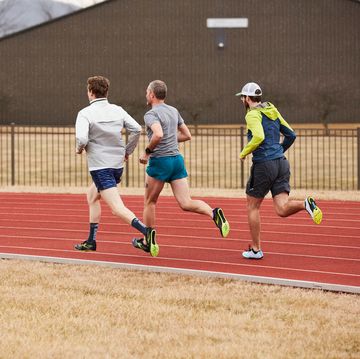In 2004, I helped a very talented runner build a solid aerobic base for the U.S. Olympic trials marathon, only to fail her during the race preparation phase of her training. I didn't take into account her drive and tenacity, and when I put her on the track, she simply ran herself into the ground. Sound familiar?
As a competitive runner, you have a certain determination, a certain resolve that helps you accomplish high goals. Intellectually, you know you shouldn't compare early season workout times to your peak season track times from previous years. Emotionally, however, you can't help it as you drive yourself based on numbers on the watch and the times in your log book. My runner did just that and ended up limping through the trials marathon. The biggest lesson learned? Fartlek runs should be your best friend before the weather warms and races spring up like daisies.
Fartlek First, Track Second
The ideal time to insert fartlek runs is when you're making the transition to faster, race-pace type training (after your winter base and before your spring race season begins). By doing a weekly fartlek run for a month before you hit the track, you'll: 1) avoid the tendency to train too hard, too early; 2) learn your effort levels and how to adjust the workout based on how you feel; 3) develop an optimal base of speed training prior to hitting the track.
Even after you complete this first month of fartlek runs and begin weekly track workouts, I suggest you insert a fartlek run every three to four weeks in place of your track workout. This will keep you from driving your body too hard on the track to hit or better your previous workout times. This break from the track is also a great way to avoid peaking too soon and risking injury by overdriving the musculoskeletal system.
Best Fartlek Workouts
Like most track workouts, there are an infinite variety of fartlek runs that can be created. Each workout below is designed to stimulate various systems in the body that sports science tells us will result in improved 5K/10K racing performance. Perform this set of workouts and you'll be ready for great track sessions.
Fartlek No. 1, Week 1—After a warm-up, perform 10 to 12 surges lasting 1 minute with a 1-minute jog rest in between. Your effort should be slightly faster than 5K race pace effort. Most runners find this to be at about 90 to 95 percent of full effort. Research indicates that running at this intensity for a total of 10 to 12 minutes results in a higher VO2 max—your ability to consume and utilize oxygen.
Fartlek No. 2, Week 2—After a warm-up, perform four to five surges lasting 3 to 5 minutes each with a 1- to 2-minute jog in between. Your effort should be slightly faster than 10K race pace effort but not as fast as in Fartlek No. 1. Most runners find this to be at about 80 to 85 percent of full effort. Research indicates that running at this intensity for a total of 15 to 20 minutes results in a higher lactate threshold—the balance point between the production of lactic acid and your ability to keep it from building up.
Fartlek No. 3, Week 3—After a warm-up, perform five to six surges lasting 2 minutes, with a 1-minute jog between each hard effort. Your effort should be very similar to 5K race pace effort. This workout stimulates your VO2 max but also helps you become more comfortable at 5K race pace. You'll find this helpful in your first races where many runners start too fast and fade in the end.
Fartlek No. 4, Week 4—This workout is the granddaddy of them all and will complete your month of fartlek running prior to hitting the track. After a warm-up, perform the following surges, all followed by a 2-minute easy jog: 5 minutes, 4 minutes, 3 minutes, 2 minutes and 1 minute. Your effort should increase as the length of the surge decreases. The 5-minute surge is at 80 percent of full effort. The 4-minute surge is at 85 percent of full effort. The 3-minute surge is at 90 percent of full effort. The 2-minute surge is at roughly 95 percent of full effort and the 1-minute surge is at nearly 100 percent of full effort. This workout is designed to mimic the increase in effort that you must make in order to race at your highest level for the 5K and 10K distances. Don't worry about pace or heart rate. Just focus on effort. Learn your body.
Simple Workout = Big Results
After our disappointment from 2004, my Olympic trials runner used fartlek running as her introduction to faster running heading into 2005. The result? She was faster than ever when we got to the track workouts. And these better track workouts led to faster racing, with PRs at every distance from the 5K to the marathon, culminating in her victory at the Houston Marathon.
For competitive runners, I have found no better workout for that critical period between your base phase and your racing season than the fartlek run. Recognize the traits that make you great and set up the training to not only stimulate the desired adaptations in the body, but also set you up for success in your peak season and avoid the most common pitfall of competitive runners—training too fast and, subsequently, racing too slow.
Greg McMillan is an exercise physiologist and USATF-certified coach who helps runners via his website www.mcmillanrunning.com.







